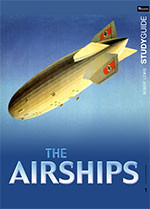Product Overview
Almost as big as a battleship, yet lighter than air, airships were the largest flying objects ever built.
In three one-hour episodes The Airships (Peter Butt/Rob McAuley, 2004) brings to television the story of these remarkable flying machines and their place in history.
When aeroplanes were still in their infancy, these remarkable craft, held aloft by lighter-than-air gas, were providing passenger services between Europe, the United States, and South America. They were carrying explorers and scientific expeditions to some of the remotest destinations on the planet, including the North Pole. In World War 1 they became the worlds first aerial bombers, Germanys secret weapon in the war to end all wars.
In 1929 the German giant, Graf Zeppelin, in effect a small flying hotel, created history when it became the first passenger aircraft to circumnavigate the world in only 12 flying days.
In the late 1920s the British Government planned a fleet of revolutionary airships to link its empire. It was a venture that ended in tragedy.
The US Navy embraced the giant airships, turning them into flying aircraft carriers that could launch and retrieve planes operating from hangers built within their giant frames.
As Hitler prepared for war, the two giant German airships, Graf Zeppelin and Hindenburg, were cleverly used to project the technological might of the Third Reich to the German people, and to the world at large.
The controversial destruction of the Hindenburg in a flaming inferno in 1937 marked the end of the era of giant airships. Two years later, the world was at war.
In World War 2 blimps successfully protected allied convoys of merchant ships from U-boat attack in the Battle of the Atlantic. Post-war, they took on a new life as commercial billboards in the sky, as aerial platforms for television cameras by providing eye-in-the-sky surveillance in the war against crime.
Today, airships are very much alive and well. New-age giants are planned to rival satellites in the stratosphere, to transport cargoes, to cater for the growing tourist market, to act as surveillance and communication platforms in the fight against terrorism. The Airships explores what may well be the dawning of a new age for airships.
The Airships reveals the dynamic international race to dominate the skies, by nations, and by extraordinary men and commercial interests seeking power, profits, and political gain. It also enables students to explore the concept of change over time through a case study in technology.







